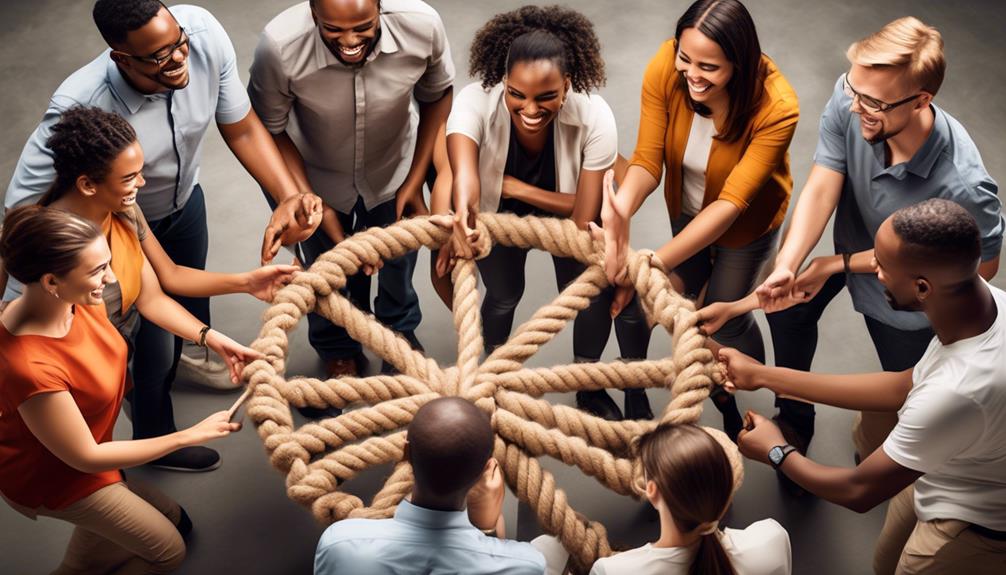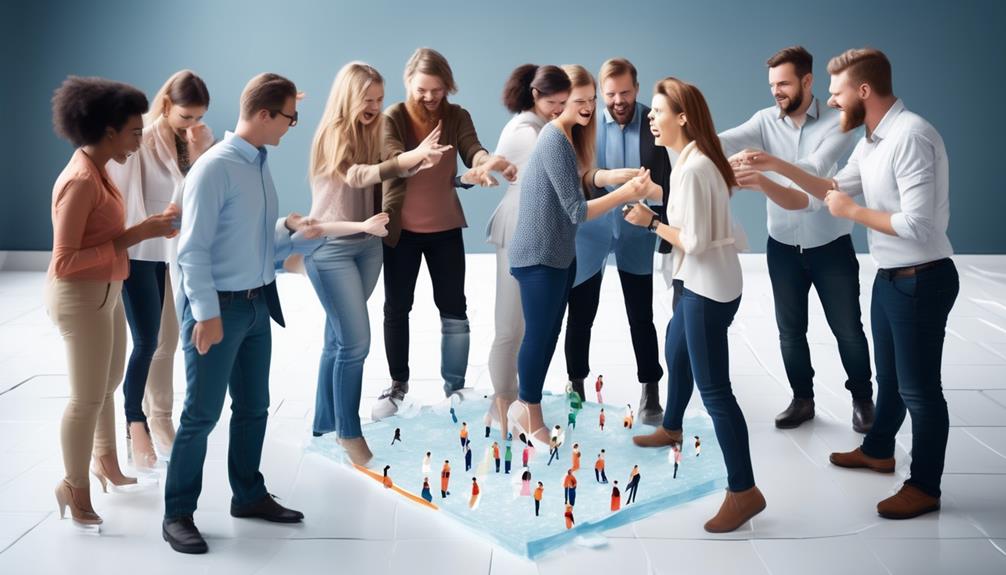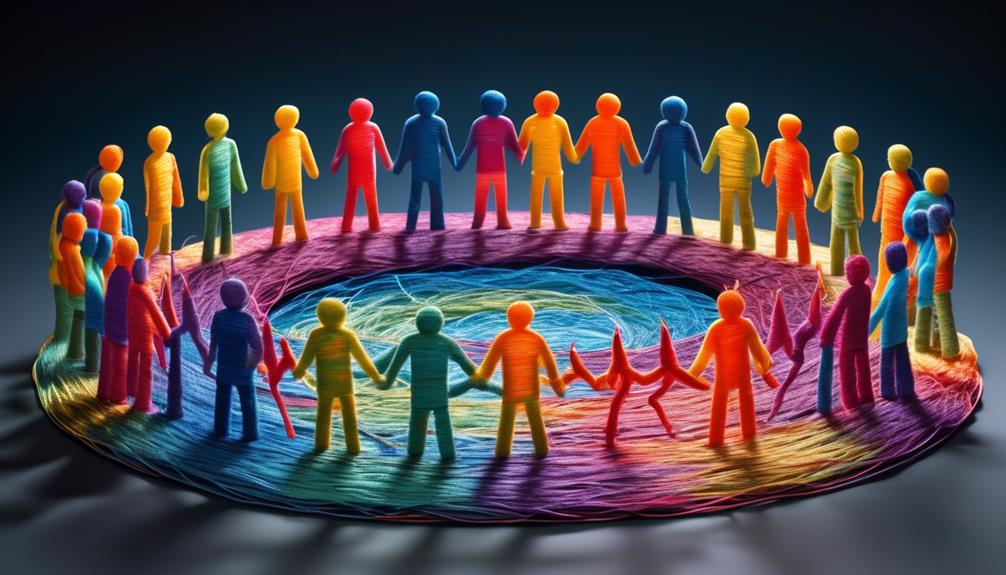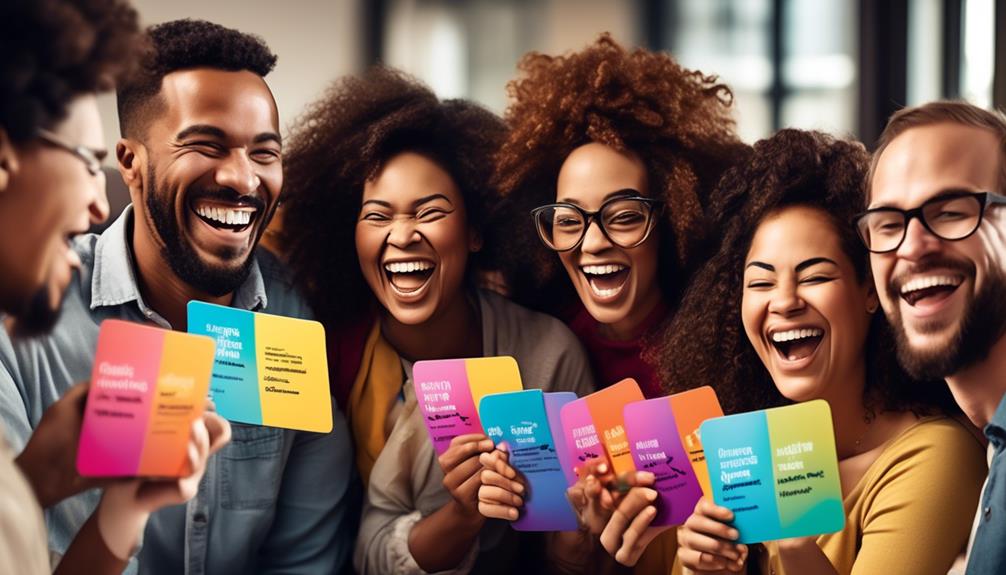Icebreaker techniques are crucial for opening the door to meaningful connections and productive interactions. Whether we are at professional events or social gatherings, it is important to have effective methods for starting conversations and creating engaging interactions.
Whether it's in person, virtually, or a combination of both, the right icebreaker strategy can make all the difference in establishing a welcoming and cohesive atmosphere. But what makes a successful icebreaker?
Join us as we explore the diverse world of icebreaker strategies and uncover the techniques that can transform a room full of strangers into a community of collaborators.
Key Takeaways
- Icebreaker strategies are beneficial for enhancing team dynamics and collaboration, fostering relationships, stimulating creative thinking, and promoting a cohesive and relaxed environment.
- In-person icebreakers, such as human bingo and stand-up comedy challenges, create a fun and interactive environment that builds rapport quickly and encourages engagement and connections among attendees.
- Fun icebreaker activities like Two Truths and a Lie, Human Knot, The Great Egg Drop, and Pictionary Relay energize the group and foster camaraderie.
- Icebreaker activities, whether in-person or remote, are essential for fostering open communication, emphasizing active listening, establishing trust, and creating a safe space for meaningful engagement.
Icebreaker Benefits
Icebreaker activities significantly enhance team dynamics and collaboration by fostering relationships, stimulating creative thinking, and promoting a cohesive and relaxed environment for strategic planning and problem-solving. These fun activities not only break the initial awkwardness but also set the stage for open and effective communication.
By building relationships among team members, icebreakers create a sense of camaraderie, leading to improved teamwork and shared understanding. The benefits extend to priming the brain for strategic planning, brainstorming, and problem-solving. This quick, unfiltered thinking can lead to innovative solutions and ideas.
Icebreakers are particularly suitable for groups of five or more, creating a relaxed and fun atmosphere where team members can express themselves freely. This sense of relaxation and enjoyment can lead to improved team cohesiveness and collaboration.
In essence, the benefits of icebreaker strategies go beyond just breaking the ice; they lay the groundwork for better communication, creativity, and teamwork.
In-Person Icebreakers

Let's talk about the fun icebreaker activities that can help build rapport quickly and foster open communication in in-person settings.
These activities are designed to break the ice and create a more relaxed and interactive environment for participants.
From human bingo to stand-up comedy challenges, there are various ways to encourage engagement and connections among attendees.
Fun Icebreaker Activities
Engaging in fun icebreaker activities during in-person meetings or workshops can set a positive and inviting tone for the group, fostering a sense of camaraderie and sparking creativity. When considering fun icebreakers, it's essential to choose activities that encourage participation and laughter. Here are a few enjoyable icebreaker activities to consider:
- Two Truths and a Lie: Encourage each person to share two true statements and one false statement about themselves, prompting the group to guess the lie.
- Human Knot: Have the group stand in a circle, reach in and grab someone's hand across the circle, then work together to untangle the 'human knot'.
- The Great Egg Drop: Provide each group with limited materials to build a contraption that will protect an egg from breaking when dropped from a certain height.
- Pictionary Relay: Divide the group into teams and take turns racing to draw and guess the sketches, adding an element of friendly competition and teamwork.
These icebreaker activities can energize the group to write.
Building Rapport Quickly
After enjoying some fun icebreaker activities, we can now focus on building rapport quickly through in-person interactions.
Open-ended questions are a great way to spark meaningful conversations and establish a quick connection with others. Sharing personal stories or anecdotes can create a sense of familiarity and relatability, helping to build rapport. It's important to show genuine interest in the other person's experiences, opinions, and background, as this can foster a strong connection.
Utilizing humor and lightheartedness can also create a relaxed and comfortable atmosphere for interaction, further enhancing rapport. Additionally, non-verbal cues such as smiling, maintaining eye contact, and mirroring body language can establish a sense of trust and connection within the group.
These strategies can help to quickly build rapport and form strong connections during in-person icebreaker activities.
Fostering Open Communication
Creating an environment of open communication is pivotal during in-person icebreaker activities for fostering meaningful connections and collaboration. Engaging in icebreaker questions and activities that promote open communication can set the stage for deeper, more authentic interactions.
Here are some practical tips for fostering open communication during in-person icebreakers:
- Encourage sharing: Icebreaker activities that prompt personal sharing can help create an atmosphere of openness and vulnerability.
- Active listening: Emphasize the importance of active listening during icebreaker games to demonstrate respect and understanding.
- Establishing trust: By creating a safe space for open communication, participants can feel more comfortable expressing themselves.
- Setting expectations: Communicate the purpose of the icebreaker activity and the importance of open communication to set the tone for meaningful engagement.
Remote Icebreakers

Incorporating remote icebreakers into virtual meetings and workshops is crucial for fostering a sense of connection and camaraderie among team members.
As we adapt to remote work, finding meaningful ways to engage with one another is essential for building strong relationships. Remote icebreakers offer a fantastic opportunity for getting to know our colleagues in a fun and interactive manner.
For instance, dividing the team into groups of five for activities like 'Two Truths and a Lie' or 'Human Bingo' can spark engaging conversations and create a sense of belonging, even in a virtual setting. These activities not only break the ice but also help team members feel more comfortable, ultimately leading to improved collaboration and increased engagement.
By incorporating remote icebreakers, we can create a positive and inclusive atmosphere in our virtual meetings and workshops, ensuring that every team member feels valued and connected.
Hybrid Icebreakers

Let's explore the concept of hybrid icebreakers, which are designed to bridge the gap between physical and remote participants.
These activities aim to create a seamless integration of in-person and virtual engagement, fostering inclusivity and interaction across both settings.
Engaging Virtual Activities
Engaging Virtual Activities, or Hybrid Icebreakers, play a vital role in fostering a comfortable and interactive atmosphere for both remote and in-person participants. These activities are essential in breaking the ice and creating a sense of connection and community within hybrid groups.
Here are some engaging virtual activities that can enhance the experience for all participants:
- Virtual games that encourage friendly competition and teamwork
- Polls to gather insights and opinions from all participants
- Storytelling sessions where individuals can share personal experiences and anecdotes
- Interactive challenges that promote collaboration and creativity
Seamless In-Person Integration
Strategically blending in-person and remote participants, hybrid icebreakers aim to foster a cohesive and inclusive environment from the outset. These icebreakers seamlessly integrate traditional in-person activities with digital tools, ensuring that all participants, regardless of their physical location, feel included and connected.
From simple introductions to collaborative activities, hybrid icebreakers bridge the gap between in-person and remote participants. To achieve seamless in-person integration, consider activities such as 'Two Truths and a Lie' where participants take turns sharing interesting facts about themselves, or 'Virtual Scavenger Hunt' where both in-person and remote participants hunt for specific items within their surroundings.
These icebreaker strategies not only break the ice but also lay the foundation for a unified and engaged group. For more ideas, check out this list.
Icebreaker Tips

Utilizing effective icebreaker tips can set the stage for productive interactions and meaningful connections in various professional and social settings. When it comes to breaking the ice, we've found that a few simple strategies can really help people engage and connect with one another.
Here are some icebreaker tips that we've seen work wonders:
- Show genuine interest: People appreciate when you show interest in them. Ask open-ended questions and actively listen to their responses. This shows that you value their thoughts and experiences.
- Use humor: A good sense of humor can instantly lighten the mood and make people feel more at ease. A well-timed joke or lighthearted comment can help to break down barriers and create a relaxed atmosphere.
- Share a personal story: Sharing a relatable personal anecdote can help others feel more comfortable opening up. It shows vulnerability and can encourage others to share their own experiences.
- Be inclusive: When facilitating group interactions, make sure everyone feels included. Acknowledge everyone's contributions and encourage quieter individuals to participate. Creating a welcoming environment is key to successful icebreaking.
These icebreaker tips are all about creating a welcoming and inclusive atmosphere that encourages genuine connections. By incorporating these strategies, we've seen how they can help people feel more at ease and open up in professional and social settings.
Icebreaker Games

Icebreaker Games are interactive activities designed to cultivate a relaxed and collaborative atmosphere at the outset of meetings or workshops, fostering participant engagement and creativity. These games set the tone for the gathering, breaking down barriers and encouraging open communication. By incorporating Icebreaker Games into our icebreaker strategies, we can enhance the overall experience for participants, promoting a sense of camaraderie and shared purpose from the start.
| Icebreaker Games | Description |
|---|---|
| Two Truths and a Lie | Participants share three statements about themselves, two truths and one lie, and others guess which is the lie. |
| Human Bingo | Participants mingle to find individuals who match descriptions in each bingo square, fostering interaction and networking. |
| Stand-up Comedy Challenge | Participants take turns sharing lighthearted jokes or anecdotes, promoting laughter and relaxation. |
| Memory Game | Participants share unique facts about themselves, challenging others to remember and recall the information, promoting attentive listening and memory skills. |
These Icebreaker Games not only break the ice but also help us to quickly build rapport, preparing everyone for the collaborative group work ahead.
Icebreaker Activities

We typically incorporate various engaging icebreaker activities to energize and foster a positive atmosphere at the beginning of our gatherings, enhancing participant interaction and setting the stage for productive collaboration. Icebreaker activities are essential for breaking down barriers and creating a sense of camaraderie among participants.
Some of our favorite icebreaker activities include:
- Two Truths and a Lie: This classic icebreaker encourages participants to share interesting facts about themselves, sparking conversation and laughter as others try to guess the lie.
- Group Juggle: This active icebreaker involves tossing a ball or object around the group, allowing participants to learn each other's names in a fun and dynamic way.
- Human Bingo: By filling out bingo cards with interesting facts about themselves, participants must interact with others to find individuals who match the descriptions, fostering connections and conversation.
- Marshmallow Challenge: This hands-on group activity involves building structures with marshmallows and spaghetti, promoting teamwork, creativity, and problem-solving skills.
These icebreaker activities aren't only enjoyable but also lay the groundwork for meaningful connections and productive group activities.
Icebreaker Techniques

At Icebreaker Strategies, our approach to fostering a positive atmosphere and enhancing participant interaction extends beyond traditional icebreaker activities to encompass a range of effective icebreaker techniques.
Our team understands the importance of employing innovative icebreaker strategies to maximize engagement and create meaningful connections within the group listed above.
One technique we find particularly impactful is the 'Two Truths and a Lie' game, where participants share two true statements and one false statement about themselves, prompting others to guess which is the lie. This not only encourages active participation but also provides an opportunity for individuals to learn more about each other in a lighthearted manner.
Additionally, we often utilize the 'Speed Networking' technique, which involves pairing participants for brief, structured interactions to exchange introductions and professional backgrounds before rotating to meet new individuals. This technique is highly effective in breaking the ice and fostering connections among participants.
Icebreaker techniques like these are instrumental in setting a positive tone for any gathering and ensuring that all individuals feel included and valued.
Icebreaker Facilitation

Facilitating icebreaker activities involves orchestrating engaging interactions to foster a comfortable and collaborative environment within a group. To be effective in this role, we must embrace creativity and adaptability. It's essential to ask the group about their preferences and comfort levels, ensuring that the activities chosen are enjoyable for everyone. Knowing the people we're working with allows us to tailor icebreakers to their backgrounds and interests, making the experience more meaningful.
- Ask the group about their preferences and comfort levels
- Ensure the activities chosen are enjoyable for everyone
- Tailor icebreakers to the group's backgrounds and interests
- Make the experience more meaningful
Effective icebreaker facilitation sets a positive and inclusive tone for meetings, workshops, or events. It's about creating a relaxed and fun atmosphere that encourages participation and open communication. By employing various activities such as storytelling, introduction interviews, polls, and team-building exercises, we engage participants and lay the foundation for meaningful connections.
Frequently Asked Questions
What Are the 4 C's in Icebreaker?
The 4 C's in icebreaker are communication, collaboration, creativity, and connection. They're crucial for successful icebreaker activities.
Communication promotes engagement and active participation.
Collaboration encourages teamwork and interaction.
Creativity triggers innovative thinking and adds excitement.
Connection fosters trust and rapport.
These elements create a positive and inclusive environment, making icebreakers fun and fostering a sense of belonging among participants.
What Are 5 Great Ice Breaker Questions?
Sure, here are five great icebreaker questions we've found helpful:
- 'What's something you're passionate about?'
- 'If you could have dinner with anyone, living or dead, who'd it be?'
- 'What's the best piece of advice you've ever received?'
- 'What's a skill you'd love to learn?'
- 'What's your favorite way to relax after a long day?'
These questions usually spark interesting conversations and help us get to know each other better.
What Are the 5 Things in Ice Breaker?
When it comes to ice breakers, the 5 things that really work are openness, positivity, creativity, inclusivity, and engagement.
These elements help foster a welcoming atmosphere and encourage meaningful connections.
Each person brings something unique to the table, and by embracing these qualities, we can create an environment where everyone feels valued and heard.
It's all about setting the stage for genuine interaction and building rapport.
What Is the Three P's Icebreaker?
We'll share the concept of the Three P's Icebreaker. It's a fantastic way to foster connection and creativity.
Participants take turns sharing three personal facts, creating a relaxed and inclusive atmosphere.
This activity adapts well to various group sizes and themes, promoting teamwork and collaboration.
It's a versatile tool for building rapport and setting a positive tone for any event or meeting.
Conclusion
In conclusion, utilizing icebreaker strategies can help create a more enjoyable and productive environment for everyone involved.
These activities provide an opportunity for team bonding, improved communication, and increased creativity.
By incorporating icebreaker techniques, whether in-person, remote, or hybrid settings, we can foster connections and build relationships that contribute to a positive and inclusive atmosphere.
Overall, icebreakers play a vital role in enhancing collaboration and making experiences more enjoyable for all participants.
Joy, as our Editor in Chief, ensures the highest standard of content. Her talent in writing is complemented by her attention to detail and passion for literature and culture. Joy’s expertise and love for the English language shine through in her editorial work, making each piece a testament to quality and clarity.










